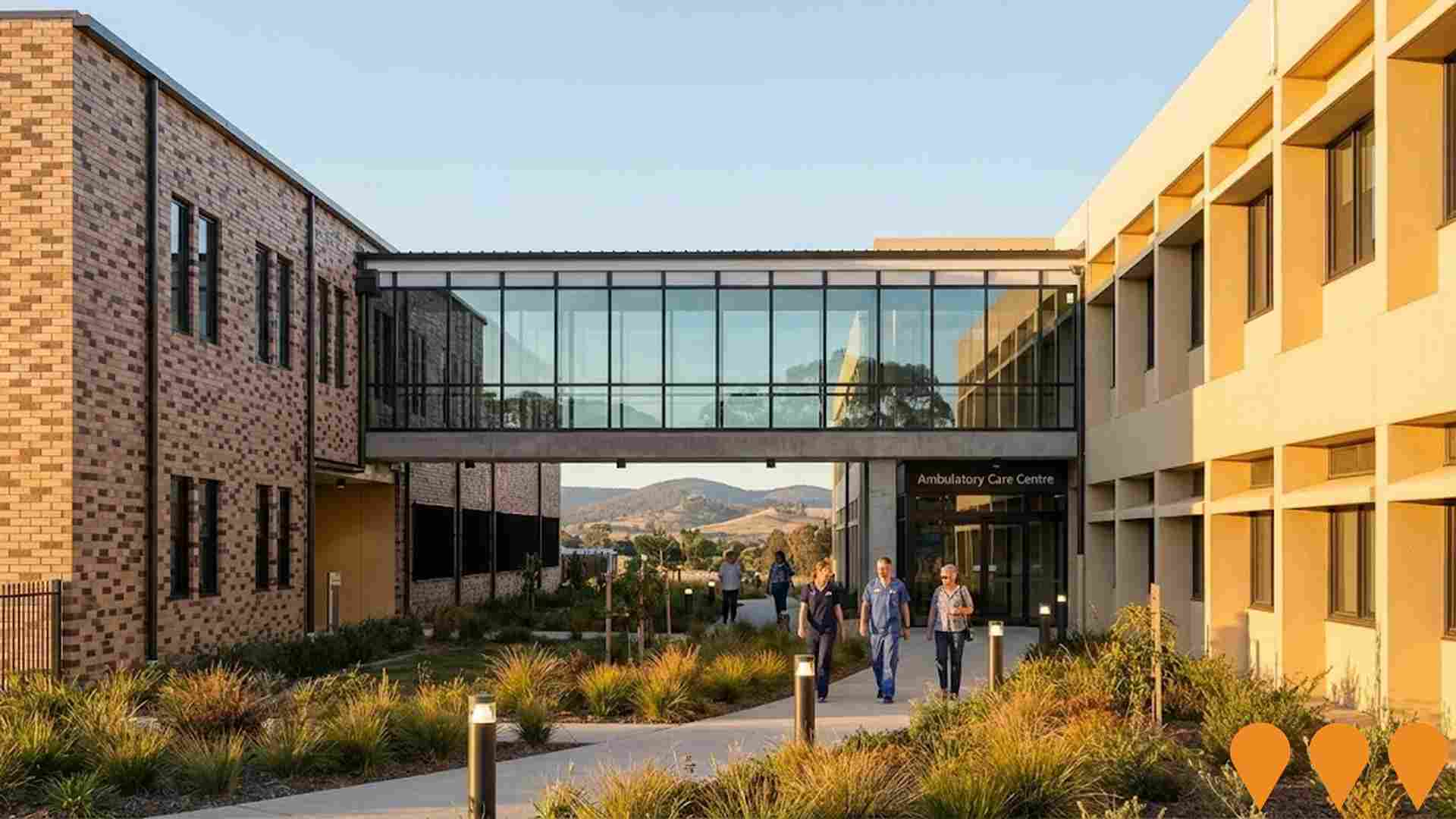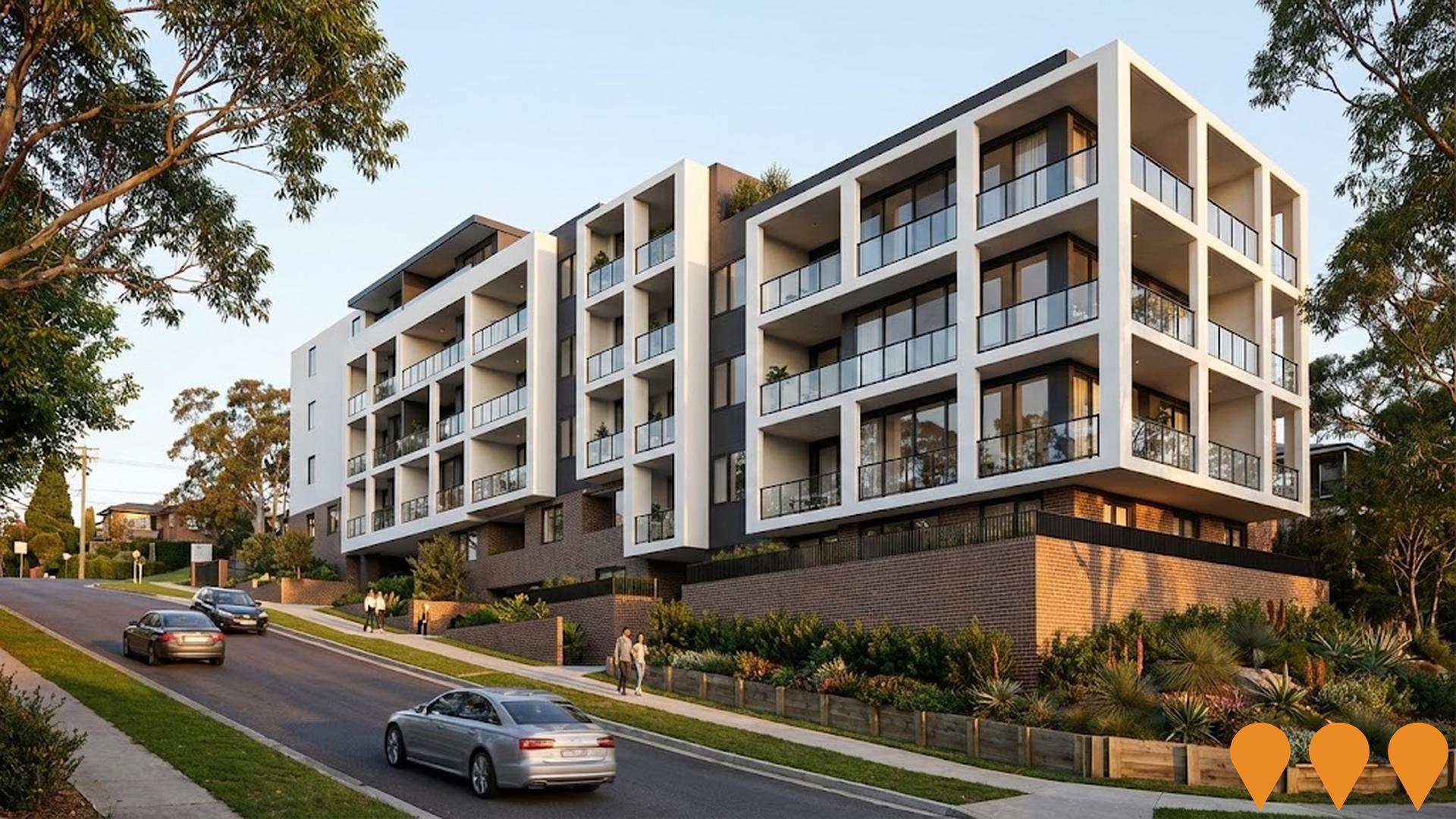Chart Color Schemes
est. as @ -- *
ABS ERP | -- people | --
2021 Census | -- people
Sales Activity
Curious about local property values? Filter the chart to assess the volume and appreciation (including resales) trends and regional comparisons, or scroll to the map below view this information at an individual property level.
Find a Recent Sale
Sales Detail
Population
Cooma has shown very soft population growth performance across periods assessed by AreaSearch
Cooma's population is approximately 6,718 as of August 2025. This figure shows a decrease of 43 people from the 2021 Census total of 6,761, reflecting an estimated resident population of 6,716 in June 2024 and an additional 50 validated new addresses since then. The population density is around 64 persons per square kilometer. Overseas migration accounted for approximately 96.8% of overall population gains recently. AreaSearch uses ABS/Geoscience Australia projections released in 2024 with a base year of 2022, and NSW State Government's SA2 level projections released in 2022 with a base year of 2021 for areas not covered by the former data.
Projections indicate an overall population decline to 6,479 persons by 2041, with specific age cohorts expected to grow; notably, the 85 and over age group is projected to increase by 103 people during this period.
Frequently Asked Questions - Population
Development
The level of residential development activity in Cooma is very low in comparison to the average area assessed nationally by AreaSearch
Cooma has seen approximately 14 new homes approved annually over the past five financial years, totalling 71 homes. In FY26 so far, three approvals have been recorded. Despite population decline in the area, housing supply has remained adequate relative to demand, resulting in a balanced market with good buyer choice. Developers focus on the premium market, with new dwellings averaging an expected construction cost of $859,000.
This financial year, $105.2 million in commercial development approvals have been recorded, indicating robust local business investment. Compared to the Rest of NSW, Cooma has markedly lower building activity, at 59.0% below the regional average per person. This constrained new construction typically reinforces demand and pricing for existing dwellings. The area's activity is also under the national average, suggesting its established nature and potential planning limitations. All new construction in the area consists of standalone homes, maintaining Cooma's traditional low density character with a focus on family homes appealing to those seeking space.
With an estimated 1604 people per dwelling approval, it reflects a quiet, low activity development environment. Given expected population stability or decline, Cooma should see reduced pressure on housing, potentially creating opportunities for buyers.
Frequently Asked Questions - Development
Infrastructure
Cooma has limited levels of nearby infrastructure activity, ranking in the 19thth percentile nationally
Changes in local infrastructure significantly affect an area's performance. AreaSearch has identified eleven projects that could impact the area. Notable ones are Cooma Festival Swimming Pool Upgrades, Alpine Rise, Cooma Crown Land Housing Development, and 3 Thurrung Street Residential Subdivision. The following list details those most likely to be relevant.
Professional plan users can use the search below to filter and access additional projects.
INFRASTRUCTURE SEARCH
 Denotes AI-based impression for illustrative purposes only, not to be taken as definitive under any circumstances. Please follow links and conduct other investigations from the project's source for actual imagery. Developers and project owners wishing us to use original imagery please Contact Us and we will do so.
Denotes AI-based impression for illustrative purposes only, not to be taken as definitive under any circumstances. Please follow links and conduct other investigations from the project's source for actual imagery. Developers and project owners wishing us to use original imagery please Contact Us and we will do so.
Frequently Asked Questions - Infrastructure
Snowy 2.0 Pumped Hydro Project
Snowy 2.0 is a 2,200 MW pumped-hydro expansion of the existing Snowy Mountains Scheme, connecting Tantangara and Talbingo reservoirs via 27 km of tunnels and a new underground power station capable of storing 350 GWh. Major works include three TBMs (Florence, Kirsten, Lady Eileen Hudson), excavation of the underground powerhouse cavern, intake/outlet structures, and new 500 kV transmission connections. As of December 2025, tunnelling is approximately 60% complete, with Florence and Kirsten progressing steadily after earlier soft-ground challenges. Powerhouse excavation is advancing, and first power remains targeted for late 2028 with full commercial operations in 2029.

Cooma Hospital Redevelopment
Redevelopment of Cooma Hospital delivering modern clinical spaces and services for the Cooma and Snowy Monaro community. Works included a larger Emergency Department (opened July 2022), a new Maternity Department (opened February 2023), and a purpose-built Ambulatory Care Centre (opened December 2023). The NSW Government invested more than $26.5 million in the project. Builder: Richard Crookes Constructions. Architect: Silver Thomas Hanley. Project manager: Johnstaff Projects.

Low and Mid-Rise Housing Policy
State-wide NSW planning reforms via amendments to the State Environmental Planning Policy to enable more diverse low and mid-rise housing (dual occupancies, terraces, townhouses, manor houses and residential flat buildings up to 6 storeys) in well-located areas within 800 m of selected train, metro and light-rail stations and town centres. Stage 1 (dual occupancies in R2 zones statewide) commenced 1 July 2024. Stage 2 (mid-rise apartments, terraces and dual occupancies near stations) commenced 28 February 2025. Expected to facilitate up to 112,000 additional homes over the next five years.

Cooma Solar Farm
Construction and operation of a 100MW solar farm with up to 80MW/320MWh battery storage system and associated infrastructure to deliver renewable energy.

Cooma Regional Sports Centre
State-of-the-art three-court indoor sports facility capable of hosting regional tournaments for basketball, netball, futsal, volleyball and badminton. Joint use facility between Council and Department of Education.

Cooma Festival Swimming Pool Upgrades
The project includes refurbishing the main 25-metre pool and rehabilitation pool, complete replacement of pipework, installation of new filtration systems, reduction of the deep end to 1.8 metres, and additional accessibility improvements such as new stairs, ramps, undercover pick-up/drop-off, and compliant fencing.

Cooma Crown Land Housing Development
Partnership between Homes NSW and Crown Lands to unlock Crown land for social, affordable and private housing development. Project includes appointment of civil contractor and real estate agent for land sales with onsite office.

Monaro High School Upgrade
Major upgrade including new performing arts centre with theatre capacity for 350 people, innovation hub with 11 specialised learning spaces, 31 new flexible learning spaces, special education facilities, new semi-commercial kitchen, upgraded wood and metal workshops, refurbished staff facilities, and landscaping improvements.

Employment
The employment landscape in Cooma presents a mixed picture: unemployment remains low at 3.2%, yet recent job losses have affected its comparative national standing
Cooma has a skilled workforce with essential services sectors well represented. Its unemployment rate is 3.2%.
As of June 2025, there are 3,238 residents employed while the unemployment rate is 0.5% lower than Rest of NSW's rate of 3.7%. Workforce participation in Cooma is similar to that of Rest of NSW at 56.4%. Key employment industries include retail trade, construction, and health care & social assistance. Notably, electricity, gas, water & waste services have an employment concentration 5.1 times the regional average.
However, health care & social assistance employs only 11.3% of local workers compared to Rest of NSW's 16.9%. The ratio of 0.6 workers per resident indicates a higher level of local employment opportunities than usual. Between June 2024 and June 2025, the labour force decreased by 3.6%, with employment declining by 4.6%, leading to an unemployment rate increase of 1.0 percentage points. In contrast, Rest of NSW saw a 0.1% employment contraction, a 0.3% labour force growth, and a 0.4 percentage point rise in unemployment. Jobs and Skills Australia's national employment forecasts from May 2025 project a 6.6% increase over five years and a 13.7% increase over ten years nationally. Applying these projections to Cooma's employment mix suggests local growth of approximately 6.3% over five years and 12.8% over ten years, though these are simple extrapolations for illustrative purposes only.
Frequently Asked Questions - Employment
Income
Income levels sit below national averages according to AreaSearch assessment
Cooma's postcode level ATO data for financial year 2022 shows median income at $51,670 and average income at $63,060. This is slightly lower than the national average. Rest of NSW had a median income of $49,459 and an average income of $62,998 in the same period. By September 2025, estimated median income would be approximately $58,186 and average income $71,012, based on Wage Price Index growth of 12.61% since financial year 2022. The 2021 Census ranks Cooma's personal income at the 43rd percentile ($771 weekly) and household income at the 26th percentile. Income analysis reveals that 29.7% of locals (1,995 people) fall into the $1,500 - 2,999 category. This is similar to the surrounding region where this cohort represents 29.9%. Housing costs allow for 87.1% retention, but disposable income ranks below average at the 31st percentile.
Frequently Asked Questions - Income
Housing
Cooma is characterized by a predominantly suburban housing profile, with a higher proportion of rental properties than the broader region
Cooma's dwelling structure, as per the latest Census, consisted of 88.5% houses and 11.5% other dwellings (semi-detached, apartments, 'other' dwellings), compared to Non-Metro NSW's 87.0% houses and 13.0% other dwellings. Home ownership in Cooma stood at 39.8%, with mortgaged dwellings at 29.8% and rented dwellings at 30.4%. The median monthly mortgage repayment was $1,300, lower than Non-Metro NSW's average of $1,408. Median weekly rent in Cooma was $290, compared to Non-Metro NSW's $300. Nationally, Cooma's mortgage repayments were significantly lower at $1,300 versus the Australian average of $1,863, and rents were substantially below the national figure of $375.
Frequently Asked Questions - Housing
Household Composition
Cooma features high concentrations of lone person households, with a lower-than-average median household size
Family households comprise 62.2% of all households, including 22.3% couples with children, 28.5% couples without children, and 10.8% single parent families. Non-family households account for the remaining 37.8%, with lone person households at 34.4% and group households making up 3.2%. The median household size is 2.2 people, which is smaller than the Rest of NSW average of 2.3.
Frequently Asked Questions - Households
Local Schools & Education
Educational attainment in Cooma aligns closely with national averages, showing typical qualification patterns and performance metrics
The area's university qualification rate is 21.3%, significantly lower than NSW's average of 32.2%. Bachelor degrees are the most common at 14.3%, followed by postgraduate qualifications (4.5%) and graduate diplomas (2.5%). Vocational credentials are prominent, with 40.6% of residents aged 15+ holding them, including advanced diplomas (10.5%) and certificates (30.1%). Educational participation is high at 28.6%, with 10.2% in primary, 6.9% in secondary, and 3.2% in tertiary education.
Cooma has a robust network of 8 schools educating approximately 1,411 students, with typical Australian school conditions (ICSEA: 994) and balanced educational opportunities. The schools include 3 primary, 2 secondary, and 3 K-12 institutions. The area functions as an education hub with 21.0 school places per 100 residents, significantly above the regional average of 13.3.
Frequently Asked Questions - Education
Schools Detail
Nearby Services & Amenities
Transport
Transport servicing is low compared to other areas nationally based on assessment of service frequency, route connectivity and accessibility
Transport analysis indicates 155 active transport stops in Cooma, including both train and bus services. These stops are served by 28 individual routes that collectively offer 307 weekly passenger trips. Transport accessibility is rated excellent, with residents typically located 157 meters from the nearest stop.
Service frequency averages 43 trips per day across all routes, equating to approximately one weekly trip per stop.
Frequently Asked Questions - Transport
Transport Stops Detail
Health
Health performance in Cooma is well below average with prevalence of common health conditions notable across both younger and older age cohorts
Cooma faces significant health challenges, with common conditions prevalent across both younger and older age groups.
Private health cover stands at approximately 51% of the total population (~3,432 people), slightly lower than the average SA2 area. The most common medical conditions are arthritis (11.3%) and mental health issues (9.8%). Conversely, 62.2% of residents report no medical ailments, compared to 67.2% in Rest of NSW. As of 2021, 23.2% of Cooma's population is aged 65 and over (1,559 people), higher than the 20.6% state average. Despite this, health outcomes among seniors are notably challenging but perform better than the general population in health metrics.
Frequently Asked Questions - Health
Cultural Diversity
Cooma ranks below the Australian average when compared to other local markets across a number of language and cultural background related metrics
Cooma's cultural diversity was found to be below average, with 84.9% of its population being Australian citizens, born in Australia (82.7%), and speaking English only at home (90.2%). Christianity was the predominant religion in Cooma, accounting for 54.9%, compared to 51.3% across Rest of NSW. The top three ancestral groups were Australian (29.9%), English (26.8%), and Irish (9.1%).
Notably, Hungarian ancestry was overrepresented at 0.5% in Cooma versus the regional average of 0.3%, as were German (4.5% vs 4.0%) and Lebanese (0.6% vs 0.4%).
Frequently Asked Questions - Diversity
Age
Cooma hosts an older demographic, ranking in the top quartile nationwide
Cooma's median age is 44 years, similar to Rest of NSW's 43 years and above the national average of 38 years. Compared to Rest of NSW, Cooma has a higher percentage of residents aged 35-44 (13.8%) but fewer residents aged 15-24 (9.6%). Between the 2021 Census and present, the 35-44 age group has increased from 12.1% to 13.8%, while the 45-54 age group has decreased from 12.3% to 10.5%. By 2041, Cooma's age composition is expected to shift notably. The 85+ age group is projected to grow by 47%, reaching 316 people from 215. Residents aged 65 and older are expected to represent 74% of the population growth. Conversely, both the 0-4 and 25-34 age groups are anticipated to decrease in number.
